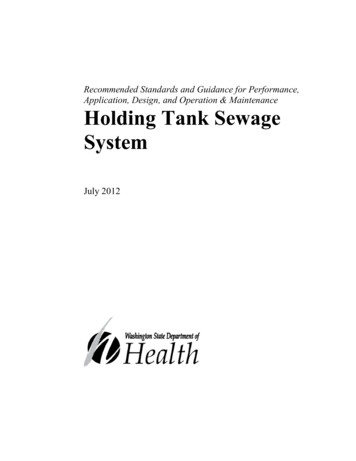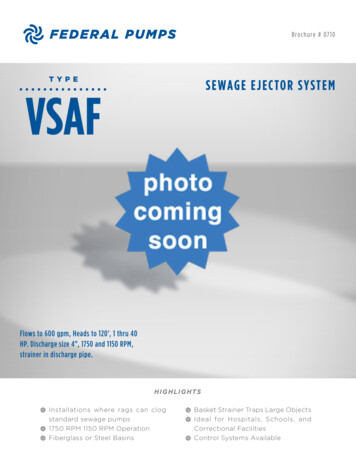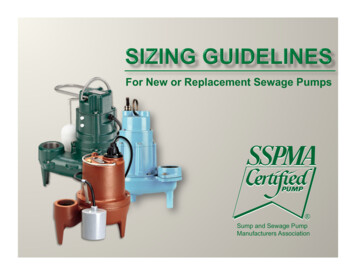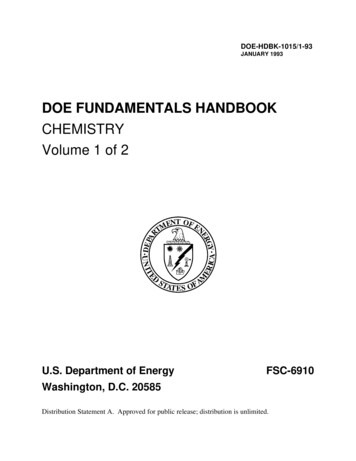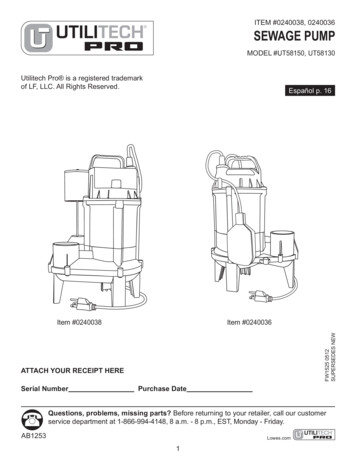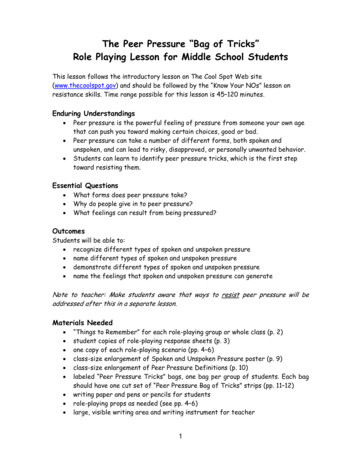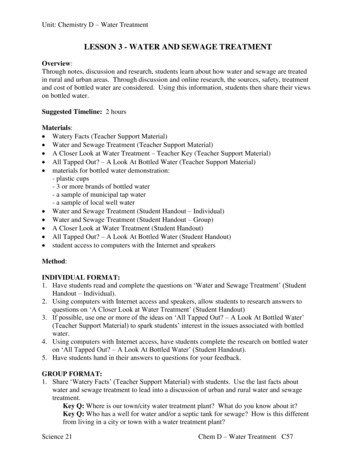
Transcription
Unit: Chemistry D – Water TreatmentLESSON 3 - WATER AND SEWAGE TREATMENTOverview:Through notes, discussion and research, students learn about how water and sewage are treatedin rural and urban areas. Through discussion and online research, the sources, safety, treatmentand cost of bottled water are considered. Using this information, students then share their viewson bottled water.Suggested Timeline: 2 hoursMaterials: Watery Facts (Teacher Support Material) Water and Sewage Treatment (Teacher Support Material) A Closer Look at Water Treatment – Teacher Key (Teacher Support Material) All Tapped Out? – A Look At Bottled Water (Teacher Support Material) materials for bottled water demonstration:- plastic cups- 3 or more brands of bottled water- a sample of municipal tap water- a sample of local well water Water and Sewage Treatment (Student Handout – Individual) Water and Sewage Treatment (Student Handout – Group) A Closer Look at Water Treatment (Student Handout) All Tapped Out? – A Look At Bottled Water (Student Handout) student access to computers with the Internet and speakersMethod:INDIVIDUAL FORMAT:1. Have students read and complete the questions on ‘Water and Sewage Treatment’ (StudentHandout – Individual).2. Using computers with Internet access and speakers, allow students to research answers toquestions on ‘A Closer Look at Water Treatment’ (Student Handout)3. If possible, use one or more of the ideas on ‘All Tapped Out? – A Look At Bottled Water’(Teacher Support Material) to spark students’ interest in the issues associated with bottledwater.4. Using computers with Internet access, have students complete the research on bottled wateron ‘All Tapped Out? – A Look At Bottled Water’ (Student Handout).5. Have students hand in their answers to questions for your feedback.GROUP FORMAT:1. Share ‘Watery Facts’ (Teacher Support Material) with students. Use the last facts aboutwater and sewage treatment to lead into a discussion of urban and rural water and sewagetreatment.Key Q: Where is our town/city water treatment plant? What do you know about it?Key Q: Who has a well for water and/or a septic tank for sewage? How is this differentfrom living in a city or town with a water treatment plant?Science 21Chem D – Water Treatment C57
Unit: Chemistry D – Water Treatment2. Use ‘Water and Sewage Treatment’ (Teacher Support Material) to guide students in filling intheir hand out ‘Water and Sewage Treatment’ (Student Handout – Group).3. Introduce some of the issues surrounding bottled water using the ideas on ‘All Tapped Out? –A Look At Bottled Water’ (Teacher Support Material).4. Allow students to research bottled water on the Internet by using their handout ‘All TappedOut? – A Look At Bottled Water’ (Student Handout).5. Discuss the answers to students’ questions and their views on purchasing bottled water.Assessment: Assessment of student’s understanding of water and sewage treatment through questioning Assessment of student’s ability to form an informed opinion on the issues surroundingbottled waterExtension: Organize a field trip to your local water and/or wastewater treatment plant Organize a field trip to a farm to learn about water and wastewater treatment Discuss the issue of safe drinking water in Canada and the many communities that live foryears with a boiled water advisory Have students write a position paper on bottled water after doing additional research on thesubjectScience 21Chem D – Water Treatment C58
Unit: Chemistry D – Water TreatmentTeacherSupportMaterial1Watery Facts3. Water use in the 20th century increased more than sixfold and continues to increase abouttwice as fast as the human population is increasing! The current average North American diet requires over 1 800 m3 of water per person per yearfrom both natural rainfall and irrigation; the diet of an average African living in the subSaharan region is produced with less than 650 m3 of water per person per year. (An Olympicsized swimming pool has a volume of about 2500 m3) It takes 48.3 gallons (about 183 litres) of water to produce one eight-ounce glass of milkwhen you add together the amounts of water needed to provide food and water for the cows,to keep the dairy barns clean, and to process the milk. It takes about 45% more water to make a slice of white bread (10.6 gallons/40 litres) than aslice of brown bread (7.3 gallons/28 litres) because more flour is used and because that flourrequires more processing to remove the brown colour.Source: Environment Canada website In Saskatoon, you can refill a 355ml (12oz) glass of water approximately 9,700 times for thesame cost as a six-pack of pop. The City of Saskatoon's Water Treatment Plant treats 130 million litres of water a day. It costs 22 cents to treat every cubic metre of sewage.Source: City of Saskatoon websiteScience 21Chem D – Water Treatment C59
Unit: Chemistry D – Water TreatmentTeacherSupportMaterial2Water and Sewage Treatment4.WATER TREATMENT Your water supply comes from your local watershed – an area that collects all precipitation.It includes lakes, rivers, streams, marshes and groundwater. Before this water is piped into your house, it must be treated so that it is safe for humanconsumption. Water is treated in different ways, depending on the area in which you live.Urban Areas – To ensure that freshwater is safe to drink, communities build water treatmentplants. Water treatment removes living organisms, dissolved minerals and human causedpollutants. When the water is finished being treated, it is pumped to homes through the watermain.Rural Areas – People living in rural settings may not have access to treated water and mayhave to dig a well on their land. A water pump then moves the water to and through thehouse. Home owners need to get a water sample tested to ensure that it is safe forconsumption. Yearly testing is recommended.Science 21Chem D – Water Treatment C60
Unit: Chemistry D – Water TreatmentTeacherSupportMaterial35.Science 21Chem D – Water Treatment C61
Unit: Chemistry D – Water TreatmentTeacherSupportMaterial4SEWAGE TREATMENTUrban Areas – Once the water has been used in your household, it must be treated before it canbe returned to the environment. Solids are settled out of the sewage water and aeration of the leftover water helps speed up the decomposition of the organic matter. The treated sewage isusually then pumped into a large body of water, such as a nearby river.Science 21Chem D – Water Treatment C626.
Unit: Chemistry D – Water TreatmentTeacherSupportMaterial5Rural Areas – Rural homes that are not connected to a community sewer system will use a septictank to contain their waste. Solids settle to the bottom of the tank and bacteria helps todecompose the organic matter. A septic truck must then come and pump out the sewage andtruck it to a nearby treatment facility.Science 21Chem D – Water Treatment C63
Unit: Chemistry D – Water TreatmentTeacherSupportMaterial6A Closer Look at Water Treatment7.Teacher KeyGo tohttp://www.city.saskatoon.sk.ca/org/water treatment/water treatment/water treament home.aspand click on the icon to watch the video on the water treatment facility in Saskatoon. Use theinformation to answer the following questions:1. How many liters of water per day does the average Saskatoon citizen use?2302. What body of water supplies the water for treatment? South SK River3. The chemical first added to the water as it enters the water treatment facility is potassiumpermanganate. What does it do?Eliminates any odor or taste.4. Separators in the plant remove sand and chemicals are added to soften the water.5. Chloramine is added to kill bacteria. Fluoride, also present in your toothpaste, is added (toharden the enamels of your teeth and prevent tooth decay).6. How long does the treatment of water take? 3-4 hours7. Once the water is treated, how does the city ensure that it is safe to drink?testing - 50,000 water quality tests done per year8. Where is the treated water stored? In one of three large reservoirsScience 21Chem D – Water Treatment C64
Unit: Chemistry D – Water TreatmentTeacherSupportMaterial7All Tapped Out?A Look at Bottled WaterMaterials a series of plastic cups, each numbered 3 or more brands of bottled water a sample of municipal tap water a sample of local well waterProcedureSet out the numbered cups, each with a sample of water in it. Have a volunteer come to the frontand taste the samples of water. Which one does he/she prefer?Points for DiscussionUse the article Bottled Water – Quenching a Planet’s Thirst led-water.html as a catalyst for thediscussion of the cost of bottled water, water quality and a comparison of bottled water andmunicipal water. Another article on the subject: Bottled Twaddle – preview available on theScientific American website at http://www.sciam.com/article.cfm?id bottled-twaddleBrainstorm alternatives to buying bottled water: bringing your own bottle and refilling it with tap water, being sure to choose the type ofbottle wisely (BPA free – stainless steel or #5 plastic) if reusing a water bottle, be sure to wash it regularly so that the water quality is notcompromisedDiscuss what the contents of the label of a bottle of water mean (use on purchased bottle of wateras an example). If students don’t know, tell them that they will find out during their research!Discuss the environmental impact of drinking bottled water – plastic waste, shipping costsTeacher Key To Online Student ResearchGo to the Health Canada website qs bottle water-eau embouteillee-eng.phpUse the information to answer the following questions:1. Why has the consumption of bottled water increased in Canada in the last few years?Sometimes it is a matter of personal taste and preference for bottled water over tap water.Consumers may also be concerned about the safety of municipal tap water, thinking thatbottled water is always safer (this is not necessarily the case).2. Is there bacteria in bottled water? Yes3. If your bottled water says “mineral water” or “spring water” on it, what does this mean?Science 21Chem D – Water Treatment C658.
Unit: Chemistry D – Water TreatmentTeacherSupportMaterial8This means that it has come from an underground source and CANNOT come from a publicwater supply. The composition of the water cannot be changed through the use of chemicals– carbon dioxide or ozone may be added to protect freshness.4. a) Where does bottled water that does not state “mineral water” or “spring water” on it,come from?It comes from any source, so it could be tap water or well water. The label say that thewater was treated in some way – for example, distilled or carbonated.b) In what other ways is it different from mineral or spring water?The water may have gone through more treatments than mineral or spring water. Thelabel must also state how it was treated (unlike mineral or spring water)5. Why should bottled water be refrigerated when opened or when stored for long periods oftime?To prevent or slow the growth of bacteria.6. How long is the “shelf-life” of bottled water? ie: what is the best-before timeperiod?2 years (although Health Canada recommends 1 year)7. Tap water is much cheaper than bottled water. For example in most North American cities,tap water costs around 50 cents for 1000 litres. Bottled water may cost up to 1 per litre. Doyou think that bottled water companies are charging too much? Why or why not?8. a) Do you and/or your family regularly buy bottled water?b) What is your reason(s) for buying or for not buying it?c) Will the information that you have learned in this class about bottled water influence yourchoice to buy bottled water in the future? If yes, how?Science 21Chem D – Water Treatment C669.
Unit: Chemistry D – Water TreatmentStudentHandoutINDIVIDUALWater and Sewage TreatmentInstructions – Read the following information and answer the questionsthat follow.Water TreatmentYour water supply comes from your local watershed – an area that collects all precipitation. Itincludes lakes, rivers, streams, marshes and groundwater.Before this water is piped into your house, it must be treated so that it is safe for humanconsumption. Water is treated in different ways, depending on the area in which you live.Urban Areas – To ensure that freshwater is safe to drink, communities build water treatmentplants. Water treatment removes living organisms, dissolved minerals and human causedpollutants. When the water is finished being treated, it is pumped to homes through the watermain.Rural Areas – People living in rural settings maynot have access to treated water and may haveto dig a well on their land. A water pump thenmoves the water to and through the house. Homeowners need to get a water sample tested to ensurethat it is safe for consumption. Yearly testing isrecommended.Science 21Chem D – Water Treatment C67
Unit: Chemistry D – Water TreatmentStudentHandoutINDIVIDUALSewage TreatmentUrban Areas – Once the water has been used in your household, it must be treated before it canbe returned to the environment. Solids are settled out of the sewage water and aeration of the leftover water helps speed up the decomposition of the organic matter. The treated sewage isusually then pumped into a large body of water, such as a nearby river.Rural Areas – Rural homes that are not connected to a community sewer system will use a septictank to contain their waste. Solids settle to the bottom of the tank and bacteria helps todecompose the organic matter. A septic truck must then come and pump out the sewage andtruck it to a nearby treatment facility.Science 21Chem D – Water Treatment C68
Unit: Chemistry D – Water TreatmentStudentHandoutINDIVIDUALQuestions:1. a) What is a watershed?b) Why do you think that the protection of watersheds is so important?2. What is added to water in a water treatment facility to soften it?3. What is soft water (Hint: You may have to research this)?4. List the role of each of the following in treating water:a) CO2b) phosphateScience 21Chem D – Water Treatment C69
Unit: Chemistry D – Water TreatmentStudentHandoutINDIVIDUALc) chlorined) fluoride5. Where does the waste that is initially removed from sewage go? (HINT: Look at yourdiagram)6. What is effluent?Science 21Chem D – Water Treatment C70
Unit: Chemistry D – Water TreatmentStudentHandoutGROUPWater and Sewage TreatmentWater TreatmentYour water supply comes from your local – an area that collects allprecipitation. It includes lakes, rivers, streams, marshes and groundwater.Before this water is piped into your house, it must be treated so that it is safe for humanconsumption. Water is treated in different ways, depending on the area in which you live.Urban Areas – To ensure that freshwater is safe to drink, communities build. Water treatment removes ,and human caused . When the water is finished beingtreated, it is pumped to homes through the water main.Rural Areas – People living in rural settings may not have access to treated water and may haveto dig a on their land. A then moves the water to and throughthe house. Home owners need to get a water sample tested to ensure that it is safe forconsumption. Yearly testing is recommended.Science 21Chem D – Water Treatment C71
Unit: Chemistry D – Water TreatmentStudentHandoutGROUPSewage TreatmentUrban Areas – Once the water has been used in your household, it must be treated before it canbe returned to the environment. are settled out of the sewage water andof the left over water helps speed up the decomposition of the organic matter.The treated sewage is usually then pumped into a large , such as anearby river.Science 21Chem D – Water Treatment C72
Unit: Chemistry D – Water TreatmentStudentHandoutGROUPRural Areas – Rural homes that are not connected to a community sewer system will use ato contain their waste. Solids settle to the bottom of the tank andhelps to decompose the organic matter. A septic truck must then come andpump out the sewage and truck it to a nearby treatment facility.Questions:1. a) What is a watershed?b) Why do you think that the protection of watersheds is so important?2. What is added to water in a water treatment facility to soften it?3. What is soft water (Hint: You may have to research this)?4. List the role of each of the following in treating water:Science 21Chem D – Water Treatment C73
Unit: Chemistry D – Water TreatmentStudentHandoutGROUPa) CO2b) phosphatec) chlorined) fluoride5. Where does the waste that is initially removed from sewage go? (HINT: Look at yourdiagram)6. What is effluent?Science 21Chem D – Water Treatment C74
Unit: Chemistry D – Water TreatmentStudentHandoutName: Date: Period:A Closer Look at Water TreatmentGo tohttp://www.city.saskatoon.sk.ca/org/water treatment/water treatment/water treament home.aspand click on the icon to watch the video on the water treatment facility in Saskatoon. Use theinformation to answer the following questions:1. How many liters of water per day does the average Saskatoon citizen use?2. What body of water supplies the water for treatment?3. The chemical first added to the water as it enters the water treatment facility is potassiumpermanganate. What does it do?4. Separators in the plant remove and chemicals are added to soften the water.5. Chloramine is added to kill bacteria. , also present in your toothpaste, isadded (to harden the enamels of your teeth and prevent tooth decay).6. How long does the treatment of water take?7. Once the water is treated, how does the city ensure that it is safe to drink?8. Where is the treated water stored?Science 21Chem D – Water Treatment C75
Unit: Chemistry D – Water TreatmentStudentHandoutAll Tapped Out?A Look at Bottled WaterGo to the Health Canada faits/faqs bottle water-eau embouteillee-eng.phpUse the information to answer the following questions:1. Why has the consumption of bottled water increased in Canada in the last few years?2. Is there bacteria in bottled water?3. If your bottled water says “mineral water” or “spring water” on it, what does this mean?4. a) Where does bottled water that does not state “mineral water” or “spring water” on it,come from?b) In what other ways is it different from mineral or spring water?5. Why should bottled water be refrigerated when opened or when stored for long periods oftime?Science 21Chem D – Water Treatment C76
Unit: Chemistry D – Water TreatmentStudentHandout6. How long is the “shelf-life” of bottled water? ie: what is the best-before time period?7. Tap water is much cheaper than bottled water. For example in most North American cities,tap water costs around 50 cents for 1000 litres. Bottled water may cost up to 1 per litre. Doyou think that bottled water companies are charging too much? Why or why not?8. a) Do you and/or your family regularly buy bottled water?b) What is your reason(s) for buying or for not buying it?c) Will the information that you have learned in this class about bottled water influence yourchoice to buy bottled water in the future? If yes, how?Science 21Chem D – Water Treatment C77
A Look At Bottled Water’ (Teacher Support Material). 4. Allow students to research bottled water on the Internet by using their handout ‘All Tapped Out? – A Look At Bottled Water’ (Student Handout). 5. Discuss the answers to students’ questions

